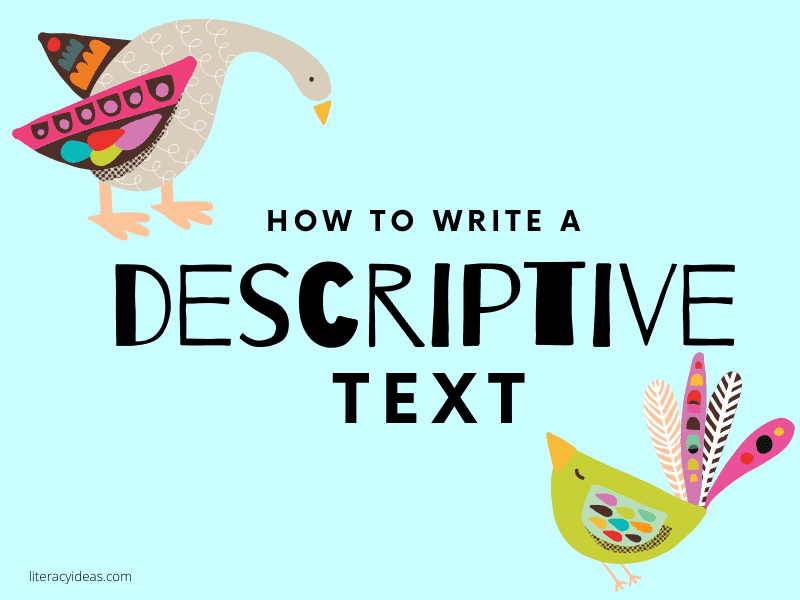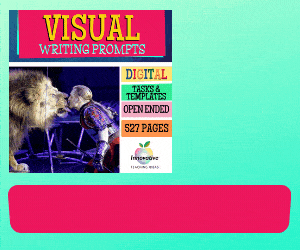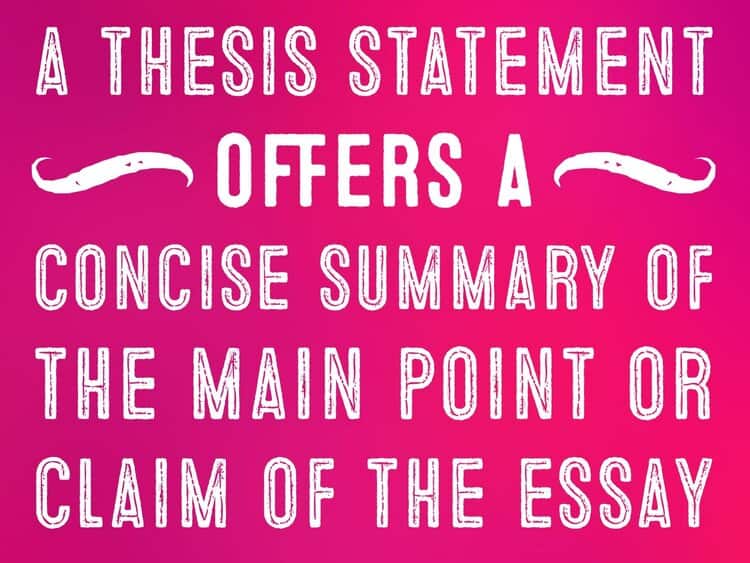Reading Literature:key Ideas and Details One Step Vloser to Freedom

WHAT IS A DESCRIPTIVE TEXT?

A descriptive text usually focuses on describing a single location, object, upshot, person, or place. It endeavors to engage all five of the reader'due south senses to evoke the sights, sounds, smells, tastes, and feel of the text's bailiwick.
Every bit with all genres of writing, we tin can guide our students on how to all-time organize and construction a descriptive text finer.
In this article, we'll accept a closer await at how to choose a topic for a descriptive text, prepare an outline, and ultimately produce a well-written descriptive text.
Let's get started!
THE STEPS TO WRITING A Corking DESCRIPTIVE TEXT
STEP #1 SELECT A TOPIC
More often than not, descriptive texts are narrow in focus. This allows for an in-depth exploration of the subject. If e'er the old aphorism show, don't tell applied to a writing genre, descriptive texts are it.
Whether you are choosing a topic for your students, or they are choosing what to write about themselves, be certain the topic is something that can sustain their interest, as well equally the reader'due south interest.
Descriptive essays require the author to go into great depth to evoke the person, place, or thing. If the writer doesn't care virtually the topic, so for sure the reader won't either.
A expert starting point for many students is to inquire them to write well-nigh something that is very personal to them. For case, childhood memories, embarrassing moments, or a favorite holiday all brand for good topics.
As the purpose of a descriptive text is to describe something and so vividly, and to express emotion so conspicuously, that the reader tin can experience information technology too, personal topics can provide the perfect fabric for this type of essay.
It is easier for us to depict those things nosotros have intimate knowledge of. This is why memories make such rich fodder for this blazon of essay.
We can think back to what things looked like, sounded like, smelled similar, tasted like, and felt like. We tin can reconjure in our listen's eye what it was similar to experience that memory at the fourth dimension, making it easier for us to recreate it again in the minds of our readers.
It is worth investing some fourth dimension to select a suitable topic for a descriptive text. A well-chosen topic tin can get a long fashion to kick-starting some adept writing by your students.
Footstep #2 WRITE A THESIS STATEMENT

The purpose of a descriptive essay is also to inform the reader on a item topic, event, or experience.
Yet, some topics are extremely broad and without setting out a clear focus for their writing, there is a danger that students writing tin veer off course equally they scramble to share with the reader everything they know about their chosen topic.
To avoid this, it is essential that students narrow downwards which aspects of their selected topic their essay volition business itself with. An effective means of doing this is by writing a thesis statement.
The thesis statement lays out the specific purpose of the text and usually it is embedded in the introductory paragraph.
While information technology can be difficult at times for students to define their thesis statement for a descriptive text, the following process should help guide students:
- Choose an interesting topic
- Reverberate on what you think about this topic
- Consider the reasons for your betoken of view
- Compose a statement that encapsulates this viewpoint.
Following the process above will assistance students to write a thesis statement that performs the ii defining tasks of a thesis statement, namely:
i. To define the topic
ii. To country a viewpoint.
While the thesis statement in a descriptive essay is not as central as in, say, a persuasive essay, it still serves the important function of orienting the reader while providing the writer with a clear focus for their energies.
Step #3 EVOKE THE Subject area'S ESSENCE
The clue is the title! To evoke the subject in the minds of the readers, your students volition demand to drill down into the essence of the thing itself.
So, how can we convey this essence in the printed give-and-take?
We experience the earth around us through our senses and it is through the use of sensory language that our students will evoke the essence of the matter they are writing about.
To help your students do this, take them create a five-cavalcade table on a sail of newspaper.
Each column will exist labelled with the name of i of the 5 senses: sight, audio, smell, gustation, touch. Students will and then begin the diverse feelings and sensations they acquaintance with their essay's topic, and they'll then list their ideas in the appropriate column on the canvas of paper.
While, for the most part, descriptive texts are nonfiction texts, there is still plenty of room here for students to practice their artistic faculties.
Encourage students to employ literary devices such every bit simile, metaphor, and personification to bring their sensory descriptions to life. This tin also be a keen opportunity to reinforce student understanding of the various literary devices themselves.
You can besides encourage students to use a thesaurus to uncover suitable and interesting adjectives to help them evoke the essence of the thing itself.
Non simply will this help them to produce a well-written descriptive text, but it will give them the opportunity to enhance their vocabulary as they work.
As students fill up out the various details they have selected, remind students it's important to always refer back to their thesis argument.
Recollect, every indicate a student makes in their essay should be in back up of their thesis statement.
STEP #iv CREATE AN OUTLINE
Now that your students accept selected an engaging topic, produced a solid thesis statement, and gathered together lots of relevant sensory detail, they'll demand to create a clear outline to organize and inform the writing process.
As with many types of essays, the standard five-paragraph essay construction will serve well here. This construction works as follows:
Paragraph 1: The opening paragraph introduces the main topic viewpoint of the essay. This will commonly include a thesis argument.
Paragraphs two,iii, & iv: These are considered the body paragraphs of the essay, with each paragraph exploring one of the supporting arguments that bear witness the thesis statement. More trunk paragraphs may be added as needed.
Paragraph v: The purpose of the determination paragraph is to restate the thesis statement, summarize the diverse points made in the essay itself, and to leave the reader with something to recall virtually.
This standard format provides a helpful template for students to outline their descriptive text before writing. Information technology volition assist ensure their writing stays focused and moves forward in a coherent manner.

STEP #5 WRITE, WRITE, WRITE!
Past this phase, students have laid more than enough groundwork to get started writing in earnest.
While they should refer closely to the prep piece of work they have done already, students should also be encouraged to permit things menses too.
Writing is as much art as it is scientific discipline. Having a clear, disciplined structure in place from the previous steps will allow students the freedom to take a chance and get artistic in their writing.
Sometimes students at this phase find information technology difficult to allow get in their writing. They want things to be perfect the start time round.
Remind them that they shouldn't exist afraid to write less than perfect sentences in their first drafts. Getting their ideas on paper is the nigh of import thing at this stage. They can always edit and rewrite later.
It's important that students sympathize that good descriptive writing is not only filled with physical details, just includes emotional content besides. Encourage your students to include the emotional significance of memories and events, people and places, too. This brings pregnant to a text.
While they exercise this, remind them once more that information technology is of import to testify rather than tell.
For case, rather than say The man was old, say something forth the lines of, The man's face was wrinkled with historic period.
While the first sentence makes a statement about the man's historic period that tells the reader their age, the second shows the issue of age on the homo'due south looks.
Good descriptive writing needs to be specific, evocative, and believable.
Encourage students to be specific in the details they cull to share with the reader. The more specific they are, the easier it will be for the reader to see things in their heed's eye.
To write evocatively, students volition need to add together some personal input into their writing. They must choose their language advisedly to evoke a response in the reader. This is achieved by because carefully the impression the word choice and sentence social club creates, as well as how they frame the field of study in their writing.
To ensure that writing is believable, students should be careful not to exaggerate, or let their imagination run away with itself! While descriptive writing employs literary devices and draws on a author'south creativity, it is not the place for fantastical hyperbole or over-flowery writing.
Past bringing discipline to bear on the artistic procedure, students will avoid their writing degenerating into mere give-and-take vomit.
STEP #6 Redraft, Edit, Proofread
For many students, this step is their least favorite. Afterwards reaching the required word count, many students are halfway out the door earlier the clack of the last keypress has died away.
Merely, this stage is crucial if students are to satisfactorily produce well-written descriptive essays. Encourage students to maintain focus as they redraft, edit, and proofread their writing.
Reviewing a finished draft is best washed with the perspective of a footling time. Where possible, encourage students to permit a typhoon marinate overnight before tackling it. Masterpieces aren't born fully formed into the world. They are moulded and crafted over time.
Where the student doesn't have the luxury of leaving the slice overnight, possibly they tin go for a walk, or work on another task for a while, before returning to edit the piece. Any type of break away from the text volition bring some freshness to their perspective.
When students are ready to review their work, instruct them that it is adept policy to take a minimum of three run-throughs to ensure they catch everything that needs catching!
On the first run-through, students should await at structural issues to ensure the descriptive text is well-organized. For case:
- Does it follow the standard five paragraph structure as outlined above?
- Does information technology contain a thesis argument?
- Is the thesis statement supported by each of the body paragraphs?
- Does the conclusion restate the thesis, summarize the main points, and leave the reader with something to retrieve about?
On the 2nd run-through, students should examine the sentences that incorporate the paragraphs, asking questions such as:
- Do they follow a clear and coherent order?
- Are they well-constructed and grammatically correct?
- Are the length of the sentences varied?
- Are the sentence structures varied?
On the third and last run-through, students should bank check word choice, spelling, and punctuation. They tin can practice this by asking question such every bit:
- Accept whatever words been overused?
- Have redundant words been removed?
- Is the copy free from spelling errors?
- Has the correct punctuation been used throughout?
One good way for students to check their ain piece of work is to read it aloud. This helps ho-hum things down, making it more than likely that they'll catch smaller mistakes they may otherwise miss.
In Conclusion
Writing descriptive texts gives students an opportunity to flex their creative muscles. It challenges them to observe new and innovative means to use language to paint pictures in the minds of readers.
This can all be very daunting for some students, especially those who find writing hard at the best of times.
The most effective way to encourage reluctant students to unleash the power of their imagination via the written discussion, is to provide them with a clear construction on which they can hang their words. The steps outlined above will provide this construction for your students.
Simply, also as ensuring students have ample practice opportunities to write, exist sure as well that students take the opportunity to read well-written descriptive texts written past proficient writers, whether in the class of poetry, essays, or novels.
ESSAY WRITING CHECKLIST & RUBRIC BUNDLE

DESCRIPTIVE WRITING TUTORIAL VIDEOS
Content for this page has been written by Shane Mac Donnchaidh. A former principal of an international school and university English language lecturer with xv years of teaching and administration experience. Shane'south latest Book the Complete Guide to Nonfiction Writing tin can exist institute hither. Editing and support for this article have been provided by the literacyideas team.
scratchleytoorepithe.blogspot.com
Source: https://literacyideas.com/how-to-write-a-descriptive-text/